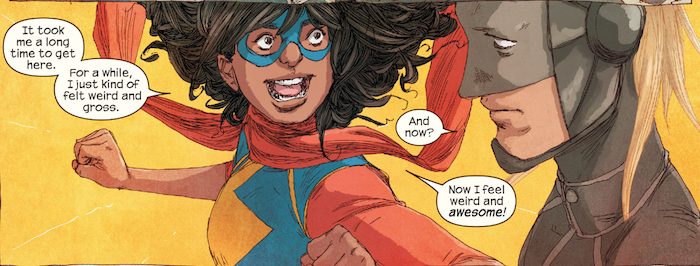
Revealing Pros’ Pros with a Nose: Perfect “Imperfections” in Comics
I have a big nose.
I don’t really think about it too much, as it doesn’t crack my insecurity fave five—but it’s there. It’s there in the mirror, in off-guard kitchen reflections, and in every photo. Lost in the woods with a dead phone battery and need the time? Lay me flat and I’ll do my best sundial.
Do you know who else has a big nose? Kamala Khan a.k.a. Ms. Marvel a.k.a. the Literal Best. And that’s part of what makes her the best, and part of why I adore her and characters like her.
In the Big Two’s shared universes, different characters pass from one set of creators’ hands to others’ all the time. Sometimes character traits are lost to friction, and other times they’re altered intentionally—hopefully for the character’s benefit. When it’s intentional, it can be genius; ditching Red Sonja’s battle-won sexuality and adding a dash of bisexuality is a brilliant part of Gail Simone’s recent Red Sonja run. When it’s unintentional, however, it’s often homogeneous.
In life, there is no default person. In fiction, there is no default person either—but major franchise owners struggle to realize that, no, your story doesn’t need to star yet another straight cis white guy.
As a result of this ingrained default, characters who deviate—especially in comics—are constantly at risk for being “washed” into something they’re not. Bisexual characters see their sexual identities treated as “phases,” “creative interpretations,” or one-off jokes. Light-skinned or mixed race characters of color progressively see their skin lightened further—often by accident because they’re assumed to be white by unknowing colorists. Rose Wilson, the former daughter of a Cambodian woman, found herself whitewashed to the point where the New 52 formally finished the job; her “new” biological mother, like Rose’s father, is white.
This penchant for homogeneity manifests in smaller ways, too. Unique facial features—like Kamala Khan’s nose—barely survive transitions between artists. When Gail Simone envisioned Scandal Savage (from Secret Six), she intended her to be short and stocky; as time marched on, Scandal got taller and more “traditionally feminine” in shape.
Kamala Khan has a big nose. Squirrel Girl has buck teeth and short hair. Zephyr is fat. Amanda Waller, in her best iteration, is also fat. She-Hulk is ripped. Wolverine is a runt.
Those qualities inform a character’s history, personality, and station. Too often, character designs are treated as latex suits that can be stretched and torn and bleached to fit every artist’s muse.
Adrian Alphona, of Ms. Marvel and Runaways fame, is brilliant because he gets why character designs matter; not only do they break from the status quo, they also vary within his stories.
Kamala has a big, curved nose. Her father has giant hands attached to giant ham arms. Her mother’s so small that she’d make Wolverine feel like a giant. Best friend Bruno has unflattering hair and will-it-won’t-it facial hair. Other best friend Nakia is angular, tall, and reserved in body language. Frenemie Zoe has a large-ish forehead—what Tyra Banks would call a “fivehead.” Alphona’s universe is rich with visual cues that make the world authentic and human (and Inhuman).
My favorite way to gauge illustration diversity is to see how the noses…go-ses. They’re the easiest detail to skimp on and make generic, and the best artists don’t.
In the recent run of Batgirl, as illustrated by Babs Tarr, Barbara Gordon has a bit of a button nose with a short—but steep—concave curve. Dinah Lance has a long, very steep nasal bridge. Roommate Frankie Charles has a wider nose, and occasional acquaintance Sevin has a bulky, convex one.
Sophie Campbell’s visual take on Jem and the Holograms does the same: Jerrica’s schnoz is the cutest of buttons, Roxy and Shana’s are wide and pronounced, Rio’s steep, and Clash rocks one that’s large and in-charge.
Is Kamala’s nose her most valuable feature? Absolutely not. Her heroism, her loyalty, her embiggening sense of self, her kindness, her humor, and her authenticity rank significantly higher on that list.
But it does make her more relatable, more accessible. Ms. Marvel teaches that you don’t have to be a supermodel to be a superhero; you don’t have to subscribe to society’s standards of beauty to have a story worth telling. You just need to be a awesome (teleporting dog is preferred, but optional).
As Kamala (rightfully) gets more popular throughout the Marvel universe, I hope every artist—no matter their style—keeps this is mind. I’m already beginning to see covers that give her westernized standards of beauty, an uncomfortable bust-to-waist ratio, and a costume that’s skewing towards spandex.
A person’s features are part of their identity. And, future Kamala Khan artists, you don’t want to know what happens with people who mess with Kamala Khan’s identity.
They get THUNK-ed.















